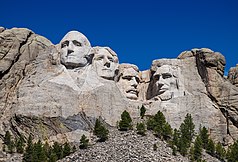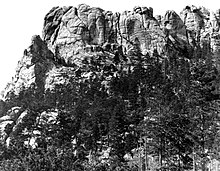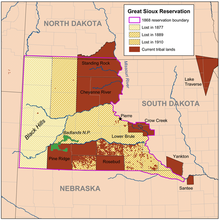Mount Rushmore National Memorial
| Mount Rushmore National Memorial | ||
|---|---|---|
| The four presidents (left to right): George Washington , Thomas Jefferson , Theodore Roosevelt, and Abraham Lincoln . | ||
|
|
||
| Location: | South Dakota , United States | |
| Next city: | Keystone | |
| Surface: | 5.17 km² | |
| Founding: | March 3, 1925 | |
| Visitors: | 2,431,231 (2016) | |
The Mount Rushmore National Memorial is a monument completed in 1941, which consists of monumental portrait heads of the four US presidents who were considered the most important and symbolic at the time of its creation . Each portrait is 18 meters high. Shown from left to right are Presidents George Washington (1st US President), Thomas Jefferson (3rd), Theodore Roosevelt (26th) and Abraham Lincoln (16th). Excerpts from famous speeches by the four presidents can be read on plaques in front of the memorial. The Mount Rushmore National Monument is also known as the Shrine of Democracy . However, it was also used as a desecration of a sacred mountain of Lakota - Indians considered the Six Grandfathers was called.
The Mount Rushmore is a 1,745 m high mountain in the Black Hills , South Dakota near the Town Keystone . The mountain owes its name to New York attorney Charles Rushmore , who originally acquired the gold mining rights for the area.
history
The idea of creating a monument to famous people in the mountains of South Dakota came from the historian Doane Robinson (1856–1946). He wanted to boost tourism in the region. Originally, he didn't think of presidents, but of well-known figures from Western history, such as Lewis and Clark , Red Cloud and Buffalo Bill Cody .
The monument was also originally planned at a different location, namely at the Needles , a bizarre rock formation in the Black Hills. Because of the poor quality of the granite and too little space for the sculptures, this proposal was rejected. The proposal also met with strong resistance from the indigenous peoples. The project only had a chance of realization when Senator Peter Norbeck (1870–1936) from South Dakota campaigned for the project and secured funding from the federal budget. The idea of the four presidential heads came from John Gutzon de la Mothe Borglum (1867–1941).
The monument was blasted, carved and chiseled into the granite of Mount Rushmore by him in 14 summers between 1927 and 1941. Construction began in 1930 on the portrait of George Washington. Thomas Jefferson's portrait began on the right in 1936. Abraham Lincoln followed in 1937 and from 1939 the portrait of Theodore Roosevelt was tackled in the rock niche.
Almost 400 workers and helpers supported Gutzon throughout the work. He himself died before the work of art was completed. His son Lincoln Borglum continued the work for a few months until it was stopped in October 1941 for lack of money and the monument was declared completed on October 31, 1941. A planned extension of the figures up to waist height was never carried out.
The monument and the associated museum are administered by the National Park Service .
Hall of Records
On the north wall of a small canyon behind the faces is an approximately 30 m × 24 m large chamber (100 feet × 80 feet), which is known as the Hall of Records (German about Hall of Records ).
Borglum originally planned to keep documents and artifacts here that are essential to US history. It should also contain the busts of well-known Americans and a list of achievements in the fields of science, industry, and the arts that the United States has contributed to all humanity. The entrance should be over 20 feet (6 m) high and 14 feet (5 m) wide, with glass doors leading to the higher chamber. A bronze eagle with a span of over 6 m (38 feet) was to be emblazoned over the door and above the inscription "America's Onward March" and "Hall of Records".
Due to Borglum's sudden death in 1941 and the entry of the USA into World War II, work on the chamber was stopped on October 31, 1941.
At the end of the 20th century, work was resumed and Borglum's dream was finally completed on August 9, 1998. In the chamber there is now a teak chest that is in a titanium safe. Inside there are 16 enameled china plaques describing how and by whom Mount Rushmore was carved into the rock, the reasons for the selection of the four presidents, and a brief history of the United States. The chest is not open to visitors, rather its contents are intended to inform people thousands of years down the road who wonder why Mount Rushmore was formed and what it is.
Claims of the Lakota Indians
Originally the mountain was called "Six Grandfathers" in the Lakota language . The mountain was part of the route Lakota guide Black Elk took in a spiritual journey that took him to Harney Peak. The Black Hills area was part of the 1868 Second Treaty of Fort Laramie . This treaty laid the area of the entire present-day US state of South Dakota west of the Missouri, including the Black Hills from the southern border with Nebraska to the 46th parallel and from Missouri in the east to the 104th meridian in the west as Indian land for unrestricted and unmolested use and settlement by the Great Sioux Nation . In 1877 the treaty was broken by the United States after gold was found in the Black Hills and the area was removed from the Great Sioux Reservation. Charles Edward Rushmore ( 1857-1931 ), after whom the memorial was named, was a New York attorney who became wealthy with gold mining rights.
To this day, the Sioux Indians do not recognize this loss of territory. They see the area as part of Pine Ridge . In the United States v. In 1980, the Sioux Nation of Indians were awarded financial compensation of $ 105 million for disregarding the Fort Laramie Treaty and other agreements. To this day, however, the Sioux refuse to accept the money. They want their ancestral land back, especially the Black Hills (Paha Sapa), which are sacred to them. You see a provocation in the monument, in particular because of the depicted President Abraham Lincoln, who in the context of the Sioux uprising , also known as the "Dakota conflict", sentenced 303 Sioux to death in 1862 and 38 Lakota Indians on December 16, 1862 in Mankato , Minnesota , in the largest mass execution in United States history. In 1971 members of the American Indian Movement occupied the monument and renamed the mountain "Mount Crazy Horse". They also set up a place of prayer on the top of the mountain. Work has been going on since 1948 on its own monument, the Crazy Horse Memorial . This monument is also controversial.
Use in media
The Mount Rushmore Monument is the setting for various feature films. One of the most famous film scenes is the dramatic showdown of the film The Invisible Third by Alfred Hitchcock , in which Eva Marie Saint and Cary Grant fight for their lives between the heads of the presidents - although these film scenes could only be shot in the studio, since, according to François Truffaut, no filming permission was granted received on site.
In the movie Mars Attacks! the Mount Rushmore Memorial is processed by the aliens with the laser of their spaceship. After the smoke has cleared, you can see four alien heads instead of the four presidential heads. In many other science fiction productions , the motif is used to add another head to Mount Rushmore, mostly it is about a president unimaginable for the circumstances of the time of the production, for example a woman, a black or an alien . Representations with such an addition of a fifth head are for example in the series Alf (episode Der Traumkandidat ), Doctor Who and Futurama .
The cover of the album Deep Purple in Rock , also interpreted as “Deep Purple in the Rock”, shows the faces of the members of the band, carved into the rock of Mount Rushmore in place of the US presidents.
See also
- Crazy Horse Memorial , 14 km southwest of Mount Rushmore.
Individual evidence
- ↑ http://www.nps.gov/moru/learn/management/statistics.htm
- ^ Mount Rushmore National Memorial . In: Encyclopædia Britannica (online), accessed July 3, 2020
- ↑ a b Mount Rushmore National Memorial South Dakota
- ↑ https://www.nps.gov/moru/learn/historyculture/hall-of-records.htm
- ↑ Oliver Wagner: Racists on Mount Rushmore , Lëtzebuerger Vollek, 8 July 2020
Web links
- National Park Service: Mount Rushmore National Memorial (official site; English)
- American Park Network: Mount Rushmore National Memorial (English)





